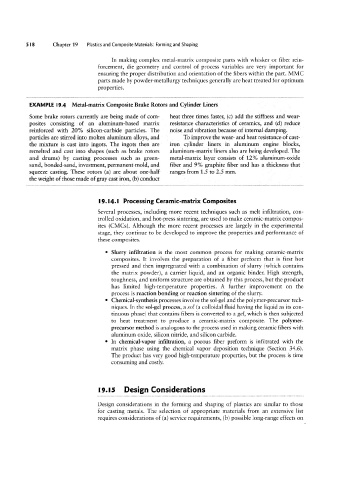Page 538 - 04. Subyek Engineering Materials - Manufacturing, Engineering and Technology SI 6th Edition - Serope Kalpakjian, Stephen Schmid (2009)
P. 538
SIB Chapter 19 Plastics and Composite Materials: Forming and Shaping
In making complex metal-matrix composite parts with Whisker or fiber rein-
forcement, die geometry and control of process variables are very important for
ensuring the proper distribution and orientation of the fibers Within the part. MMC
parts made by povvder-metallurgy techniques generally are heat treated for optimum
properties.
EXAMPLE |9.4 Metal-matrix Composite Brake Rotors and Cylinder Liners
Some brake rotors currently are being made of com~ heat three times faster, (c) add the stiffness and wear~
posites consisting of an aluminum-based matrix resistance characteristics of ceramics, and (d) reduce
reinforced with 20% silicon-carbide particles. The noise and vibration because of internal damping.
particles are stirred into molten aluminum alloys, and To improve the Wear- and heat resistance of cast-
the mixture is cast into ingots. The ingots then are iron cylinder liners in aluminum engine blocks,
remelted and Cast into shapes (such as brake rotors aluminum-matrix liners also are being developed. The
and drums) by casting processes such as green- metal-matrix layer consists of 12% aluminum-oxide
sand, bonded-sand, investment, permanent-mold, and fiber and 9% graphite fiber and has a thickness that
squeeze casting. These rotors (a) are about one-half ranges from 1.5 to 2.5 mm.
the Weight of those made of gray cast iron, (b) conduct
l9.l4.l Processing Ceramic-matrix Composites
Several processes, including more recent techniques such as melt infiltration, con
trolled oxidation, and hot-press sintering, are used to make ceramic-matrix compos-
ites (CMCS). Although the more recent processes are largely in the experimental
stage, they continue to be developed to improve the properties and performance of
these composites.
° Slurry infiltration is the most common process for making ceramic-matrix
composites. It involves the preparation of a fiber preform that is first hot
pressed and then impregnated with a combination of slurry (Which contains
the matrix powder), a carrier liquid, and an organic binder. High strength,
toughness, and uniform structure are obtained by this process, but the product
has limited high-temperature properties. A further improvement on the
process is reaction bonding or reaction sintering of the slurry.
° Chemical-synthesis processes involve the sol-gel and the polymer-precursor tech-
niques. In the sol-gel process, a sol (a colloidal fluid having the liquid as its con-
tinuous phase) that contains fibers is converted to a gel, which is then subjected
to heat treatment to produce a ceramic-matrix composite. The polymer-
precursor method is analogous to the process used in making ceramic fibers with
aluminum oxide, silicon nitride, and silicon carbide.
° In chemical-vapor infiltration, a porous fiber preform is infiltrated with the
matrix phase using the chemical vapor deposition technique (Section 34.6).
The product has very good high-temperature properties, but the process is time
consuming and costly.
l9.I5 Design Considerations
Design considerations in the forming and shaping of plastics are similar to those
for casting metals. The selection of appropriate materials from an extensive list
requires considerations of (a) service requirements, (bl possible long-range effects on

